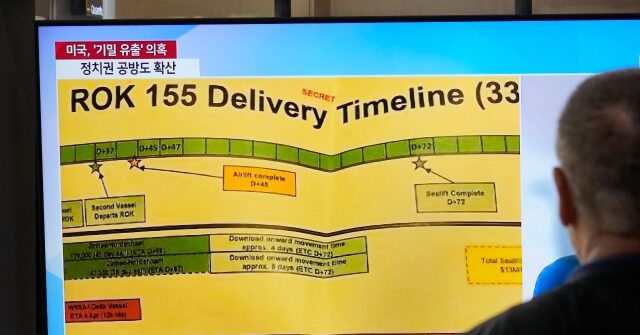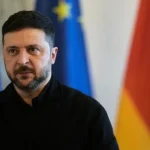

The Pentagon continued on Wednesday to respond to the fallout from the surfacing of dozens of documents online, allegedly featuring highly-sensitive U.S. intelligence, implicating Washington in everything from on-the-ground operations in Ukraine to spying on top-ally South Korea.
While most corporate media have insisted on referring to the document dump as “leaks,” officials in the administration of leftist President Joe Biden have not confirmed that someone within the U.S. government leaked the information at all – or even how much of the information is real.
At least five foreign governments — Ukraine, Russia, Egypt, the United Kingdom, and South Korea — have denied the authenticity of at least some of the information in the documents or called the documents themselves counterfeit. The Pentagon itself has described some of the documents to reporters as “doctored” but has not clarified how many or which ones, leading some media outlets to speculate the Pentagon itself may not know.
“The Biden administration is not yet sure how extensive the document leak is, and still doesn’t know who is behind it,” CBS News reported on Tuesday. In their own reporting, Biden administration officials were careful not to confirm that the documents are, in fact, a leak.
“I think we just need to be careful right now speculating or guessing what might be behind or who might be behind what looks like a potential leak here of classified information,” White House National Security Council Coordinator for Strategic Communications John Kirby said on Tuesday.
Chinese propaganda outlets, gleefully watching from the sidelines, compared the ongoing scandal on Tuesday to the 2013 National Security Agency (NSA) leaks by Edward Snowden, which revealed that the NSA had broad access to social media platforms and was spying on millions of American citizens through a program called “PRISM.”
The comparison is an illustrative one because of a critical difference in how the leakers approached the information in their hands.
Snowden, intent on alerting the world to the existence of covert espionage programs on law-abiding Americans, took his leaks directly to journalists who could help the public clearly digest the information he stole from the U.S. government. Snowden also did little to hide his own identity, becoming an overnight celebrity fugitive and, ultimately, a Russian regime folk hero. Snowden made it clear from the start that his goal was to expose confidential information.
The alleged Pentagon “leaks” are doing little to educate anyone. From the nature of the alleged “leak” — documents surfacing on the belligerent meme site 4chan or between players on the video game platform Discord — to the way the documents appear to have been either doctored or fabricated — but not enough to allow the Pentagon to dismiss them entirely — the objective of whoever is behind the operation appears to be to cement chaos.
In an attempt to trace the origin of the documents, the U.K. Guardian illustrated on Tuesday to what extent public illumination seemed to be far from the goal of those obtaining, or creating, them as possible. Users of the video game platform Discord apparently began sharing the documents – including multiple versions of the same document, some clearly altered or fabricated – amid gamer arguments.
“After a brief spat with another person on the server about Minecraft Maps and the war in Ukraine, one of the Discord users replied: ‘Here, have some leaked documents’ – attaching 10 documents about Ukraine, some of which bore the ‘top secret’ markings,” Aric Toler, an analyst at the investigative research group Bellingcat, told the Guardian. Minecraft is a popular online video game; those documents appear to have been shared in early March.
The Guardian noted that they seemed to have come from a server for “fans of the Filipino YouTuber WowMao,” that in turn had taken them from another server called “Thug Shaker Central.”
The Washington Post added to the intrigue on Wednesday evening by identifying the leaker as the alpha member of “Thug Shaker Central,” a “young, charismatic gun enthusiast” identified only as “OG.” The Post claimed that an anonymous admirer of OG’s shared conversations from the Discord server and detailed how OG distributed transcribed content, then photos of the alleged Pentagon documents, among the group of about 25 people. OG’s objective, he claimed, was to receive praise and establish himself as the leader of the group of young men.
The Washington Post‘s source, the newspaper noted, is a child.
The child explicitly rejected comparisons of “OG” to Edward Snowden.
Later on Thursday, the New York Times claimed to identify “OG” as 21-year-old Jack Teixeira, “a 21-year-old member of the intelligence wing of the Massachusetts Air National Guard.”
The documents were reportedly simmering on Discord servers — and on the pages of 4chan and threads on the Russian communications application Telegram — since January. Given the urgency of the details in the documents, had they been “leaked” or otherwise obtained by someone intent on alerting the public, this mode of dissemination seems, at best, inefficient.
The alleged American intelligence documents touch on a variety of sensitive geopolitical topics, though most appear to address the ongoing Russian invasion of Ukraine in some form. Some of the documents allegedly revealed the existence of special forces from America, France, and the United Kingdom on the ground in Ukraine, while others revealed pessimism on the part of the U.S. government that Ukraine could win the war. Others included Ukrainian asset locations and detailed assessments of Ukraine’s military abilities.
The documents that focus exclusively on the situation in Ukraine, some experts have noted, expand on the public’s knowledge of the extent of Western, and specifically American, involvement on the ground but are not necessarily bombshells or unexpected information.
“I haven’t seen anything in the documents I’ve seen that would cause me as a commander to change my plans,” Retired Lt. Gen. Mark Hertling told the left-wing outlet CNN on Tuesday. “It’s given some information to the Russians in terms of unit locations and ammo and equipment capabilities, but I would venture to say the Russians already knew all that anyway.”
The information involving third-party countries, if true, appears to be far more damaging as it calls into question America’s relationship with friendly countries. One document claimed, for example, that U.S. intelligence had reason to believe that Egyptian President Abdel Fattah al-Sisi, who maintained poor relations with former President Barack Obama but had warmed up to the United States under Donald Trump, had greenlit the manufacture of 40,000 rockets for Russia to use in the Ukraine invasion (Egypt denied the allegations).
Another alleged “leak” claimed that Serbia, one of Russia’s closest allies, had agreed to arm Ukraine.
A third bit of alleged intelligence claimed that the Biden administration was concerned that newly inaugurated Brazilian President Luiz Inácio Lula da Silva, who had personally insulted Ukrainian President Volodymyr Zelensky while campaigning last year, would aid Putin.
In perhaps the most damning (if true) document, one of the alleged leaks claimed that South Korean officials in the administration of conservative President Yoon Suk-yeol had reservations about selling military hardware to Washington because they did not trust that Biden would not send them to Ukraine, involving Seoul in a war it did not have any interest in joining. That claim was of particular concern because the document detailing it claimed that information came from “signals intelligence” – meaning Washington was spying on Yoon’s top officials.
South Korea is one of America’s closest allies, and Yoon, in particular, has prioritized improving relations with America after his predecessor, Moon Jae-in, attempted to bring South Korea into China’s orbit. Yoon will visit Washington on April 26.
Yoon officials said on Monday that they have reason to believe the documents involved in the alleged leak are “forged” but did not specify if all of them were or, if not, which were counterfeit. South Korea, like several other foreign governments implicated in the leaks, has simply dismissed them. The Pentagon has not been able to do so, but its public statements have been so vague and confusing that some media outlets suspect the Pentagon itself does not know which of the documents came from the Defense Department or even which of them contain real information.
Asked if the threat of more documents surfacing was contained on Tuesday, Kirby, the White House spokesman, shrugged: “We don’t know. We truly don’t know.”
Notably absent from the conversation is the possibility that the documents were stolen from outside, or hacked.
Given to what extent South Korea has become a protagonist in the leaks, the question of potential North Korean involvement merits some answers. Communist North Korea operates one of the most sophisticated cybercrime operations in the world, though it is typically used to fund the country’s nuclear program through theft. The FBI confirmed last year, for example, that the North Korean government had stolen as much as $600 million in cryptocurrency from an online video game network in one operation. North Korea is also believed to be a prime suspect in the 2017 “WannaCry” ransomware virus incident, which took hostage over 200,000 computers, including some owned by major international corporations such as FedEx and Honda and government agencies such as the British National Health Service.
Neither the Pentagon nor the White House have publicly suggested that the current document dump online is anything but a leak though they have also not confirmed that it is a leak.
“The Department of Defense is working around the clock to look at the scope and scale of the distribution, the assessed impact and our mitigation measures. We’re still investigating how this happened, as well as the scope of the issue,” Chris Meagher, assistant to the Secretary of Defense for Public Affairs, told reporters on Monday. Meagher admitted the agency was “still trying to assess what might be out there.”
On Tuesday, Meagher refused “to get into the validity of the purported documents,” claiming Pentagon officials were still busy trying to figure out which of the documents posted online was real and where they may have come from.
We’re not going to get into the validity of the purported documents posted online, but a Pentagon team continues to review and assess the veracity of the photographed documents that are circulating on social media sites and that appear in some cases to contain sensitive and highly-classified material,” he said.
“These photos appear to show documents similar in format to those used to provide daily updates to our senior leaders on Ukraine and Russia-related operations, as well as other intelligence updates. Some of these images appear to have been altered,” Meagher told reporters.
“We’ve been in close touch with the White House and with interagency partners on this issue, and an interagency effort has been set up with a focus on assessing the impact these photographed documents could potentially have on U.S. national security and on our allies and partners.”
Fox News, which loudly declared on Tuesday it would not publish any of the documents, cited anonymous sources saying that, assuming some of the documents are real, they may not have come from the Defense Department.
“Separately, among the classified documents published online, there is also highly classified intelligence that was not part of any of the Department of Defense briefing books, Fox News has learned,” the outlet claimed. Among potential agencies implicated are “the DOD’s office of Intelligence and Security, Public Affairs, Office of General Council, Legislative Affairs and the Joint Staff.”






